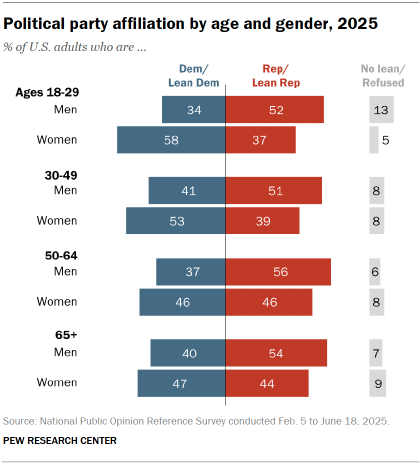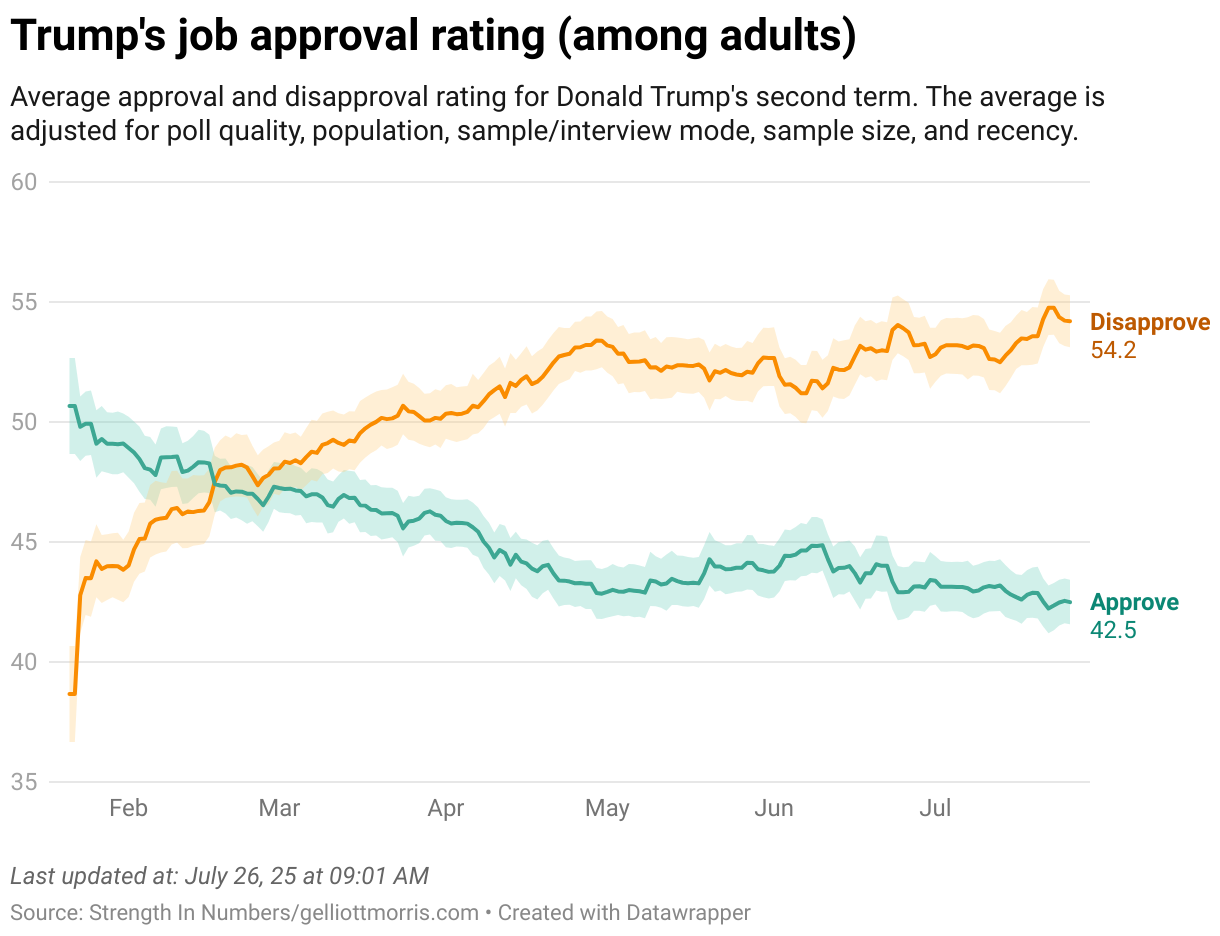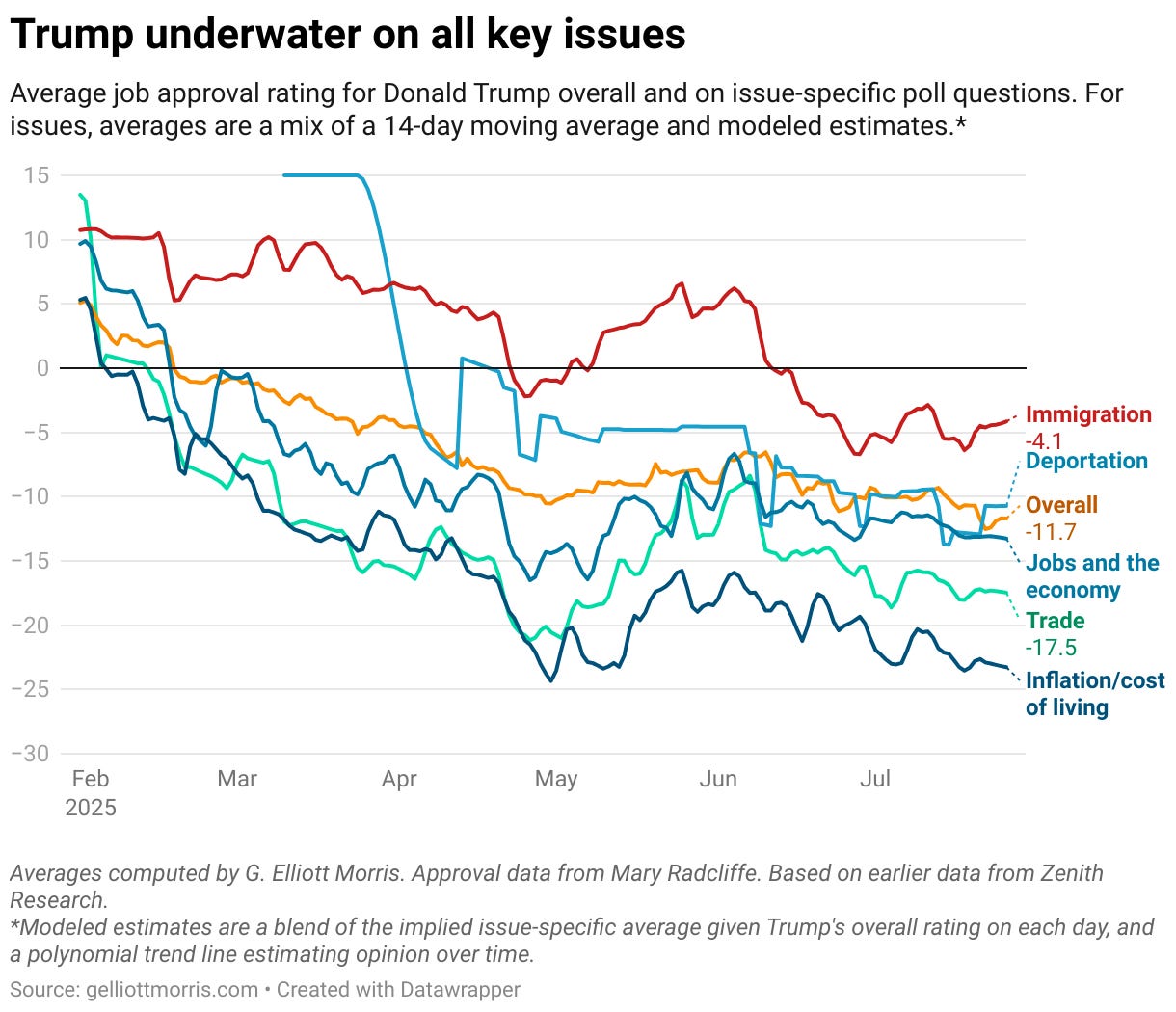Trump's approval with independents sinks below Biden's, Trump's post-Jan. 6 | Weekly roundup for July 27, 2025
This week in political data: Gallup's newsy poll; Pew benchmark data; Senate race ratings; Manufacturing prices increase; and AI disrupting news traffic
Dear readers,
Welcome back to Strength In Numbers. This is your Sunday briefing covering new data on politics and public opinion.
Thanks to everyone who submitted questions for our July poll with Verasight. This month’s survey turned up some interesting insights, and I look forward to reading more suggested topics for August!
Trump hits new record low with independents
The poll I saw circulating most online this week is a new Gallup survey of Trump’s first six months in office. Gallup finds Trump with a 37% approval rating among adults (a new low across all pollsters) and losing ground on all issues.
Strikingly, Gallup finds that just 38% of Americans approve of how Trump is handling immigration, and 37% approve of his job on the economy — the two issues that probably won him the 2024 election. Trump has lost double digits on handling the federal budget and 6 points on trade/tariffs.
The 37% rating is definitely headline-making, but it’s Trump’s approval with independents that caught my attention.
According to Gallup, just 29% of independents — fewer than one in three swing voters — approve of how Trump is doing as president today. Here’s Gallup’s chart of approval by party affiliation:
It’s hard to characterize just how bad 29% approval with independents is. You can explain the number in a couple of ways: First, 29% is somewhere between 11 and 17 percentage points lower than the president’s share of the vote with independents in the 2024 election (VoteCast says 40%, Edison says 46%). That means that roughly one out of every three political independents who voted for Trump in the 2024 election now says they disapprove of how he’s governing.
As it turns out, 29% among independents is also a record low for Trump, according to Gallup. Here is their trend for Trump among indies in his first term. He bottomed out at 30% after the attempted coup on Jan. 6, 2021.
Yes, according to Gallup, Trump’s approval rating with independents is now lower than it was after Jan. 6.
As a final point of comparison, Trump is now about as unpopular with independents as Joe Biden was during the worst point of his presidency. Biden bottomed out at 27% among independents in Dec. 2023, when media sentiment toward the economy hit a post-COVID low. And this isn’t just a Gallup thing; other polls show Biden hitting a bottom close to 30% over his term.
That’s pretty bad! Still, Trump has mostly been able to push through his unpopular agenda in Congress, so the political consequences of a 29% approval rating with independents are questionable. In terms of electoral consequences, though, the party in the White House is not winning elections when the president is only getting one in three independents.
What you missed at Strength In Numbers
SIN published two articles last week:
And here’s last week’s data roundup.
This week’s agenda includes publishing the monthly Q&A on Tuesday, sharing a big public spreadsheet of Strength In Numbers/Verasight polling crosstabs mid-week, and releasing our generic ballot average on Friday. Get subscribed so you don’t miss any news!
Even more numbers!
Some links to new data published in last week:
The Pew Research Center released the results of its annual high-response-rate political benchmarking survey. The thing everyone cares about is party ID: Republicans have a 46-45 advantage, which, depending on how you’re rounding, is one point smaller than their advantage in 2024. The long-term trend is not good for Democrats (the public was D+6 in 2020), but that’s not news. Pew does have a graph of party by gender that reinforces the trend against Democrats among young men:
Sticking with Pew for one more link, the polling methods team there also announced this week that the company will be weighting its political surveys for past vote going forward. For a lot of reasons, I think this is smart and good.
Here’s a piece by Strength In Numbers contributor Jesse Richardson, over at his Substack, on the success of the “Don’t rank Cuomo” campaign in the Democratic NYC Mayoral primary last month. Jesse points out that if you eliminate Zohran Mamdani and Brad Lander and re-flow the election, Adrienne Adams, who won just 4% of the vote in the first round, would have ended up beating Andrew Cuomo (who won 36%). RCV can lead to some funky outcomes, though this is to be expected, since Adams is more ideologically representative of the NYC Democratic electorate than Cuomo.
A new Wall Street Journal poll out this week shows the favorability rating of the Democratic Party falling even further below the GOP’s.
Political scientist Jay Ulfelder points out that Democratic legislators are much older than Democratic voters — and that the age bias between representatives and voters is much higher for Democrats than Republicans. I’ve been arguing that this is a big reason why the Democratic Party’s favorability ratings are so low with Democrats; The people in charge are not representative of the party’s supporters (do you think the average Democrat wants Chuck Schumer in charge?).
Wait! More Pew!1 Researchers did a troubling study of web traffic and found that AI summarizations — which you may have noticed on Google and some other browsers — are leading to a big decline in Search engine referrals to source material. Pew says: “Users who encountered an AI summary clicked on a traditional search result link in 8% of all visits. Those who did *not* encounter an AI summary clicked on a search result nearly twice as often (15% of visits).”
In other words, if everyone saw an AI summary for every search query, web referral traffic would basically be cut in half. Ad revenue for digital websites is already catatonic, and that would kill it completely.
Economist Brad DeLong writes: “Policy Uncertainty, Not AI-Automation, Is Almost Surely Behind the Bulk of Recent Graduates' Job Discontent”. DeLong points to recent analyses of jobs data showing, for the first time in a long time, that recent college graduates have a higher unemployment rate than more seasoned workers. People are blaming this on AI.
DeLong counters and says broader policy uncertainty — tariffs, taxes, inflation, international relations, and then AI — is to blame. Uncertainty has paralyzed business and job-switchers, leading to a decrease in openings of junior positions. And this is happening everywhere, not just in tech, where you’d expect the biggest hit to new jobs from AI (LLMs are better at coding than writing).
My take: Whether it’s AI or policy uncertainty, the upshot is that young people will have a lot more trouble than they do now finding good career-ladder positions soon. Given the demographics of (a) who goes to college and (b) who chooses STEM careers, we are probably only a few years away from young men having the highest unemployment rate of any group. Given their politics, I wonder about the political consequences of America having a bunch of young dudes hanging around with nothing to do. Twitch or tyrants?
The team behind the SCOTUS Poll has run the numbers and found that the public agrees with most Supreme Court rulings over the last year. While it’s notable when this happens, it’s usually not the case — so much so that just a few years ago the team wrote a journal article about how the Court is reliably right-leaning.
Paul Krugman points out that Trump’s tariffs are now starting to put cost pressure on many businesses, for example, leading to an increase in the percentage of manufacturing businesses that say they are having to pay higher prices for goods.
Krugman (rhetorically, I assume) asks, “What the heck were the Trumpists thinking?” You could also title this article “Trump’s policies are doing the most damage to the business he says he’s trying to protect.” That’s a pattern across his administration’s policies, actually, from the tariffs, to immigration (services sector and farms rely on cheap labor), and the BBB (rollback of health subsidies and Biden’s manufacturing credits will hit red states hardest).
The answer to Krugman’s question is “They weren’t.”
The Chronicle of Higher Ed reports on Gallup polling showing that public confidence in the higher education industry is increasing. Thermostatic public opinion, anyone?
New Inside Elections Senate ratings are out. They rate two Democratic seats (MI and GA) and one Republican seat (NC) as tossups, rate Maine as Tilt R, and MN D), IA (R), and TX (R) as Likely.
If you did the math on those probabilities, it probably works out to something like a 20% chance Democrats win the Senate next year. Remember, Dems have to win FOUR Republican seats (the best bets are NC, ME, TX, and IA) while not losing any current seats to overcome JD Vance’s tiebreaker.
Updates from the data portal
Trump approval update: After bottoming out at nearly 55% disapproval and 42% approval, a few favorable surveys push Trump back closer to the -11/-12 net approval mark.
Issue approval update: It looks like Trump’s numbers on deportations and the economy have stabilized for now in the -10 to -15 range. He may have slightly recovered some ground in “immigration” over all, but there is a decent amount of noise in the estimates (I’m hoping to add the uncertainty intervals soon).
The charts on the data portal update every day. Feel free to use and cite them liberally!
And that’s it for this week!
If you have any feedback on the format or content of this post, email me at feedback@gelliottmorris.com or submit it anonymously here. I read every email I receive.
Thanks for being a part of our nerdy little corner of the internet. I’m glad we have this space,
Elliott
This is a lot of Pew this week, and it’s not necessarily all in order. A behind-the-scenes look at how this newsletter is compiled: Every week, I use a browser extension to save interesting articles and social media posts to a note-taking app called Obsidian. The extension saves the posts in chronological order, unless I’m on my phone, and then things are alphabetical. When it’s time to write, I go through that list (a list of text files on my computer storing text of the article, images, and URLs) and write up the “More numbers!” section in the order the articles appear. Pew stuff came up first this week in alpha order for mobile articles, then again in chronological order for things saved from my laptop.
I suppose this is more than you ever wanted to know about my reading habits. But the upside is I can make a pretty cool database of all the web links I have ever read! (Or at least read and thought to save for later.)









He crashed and burned during the first term and Independents came rushing back…only to bail on him again not even a full year into term two. Why are Americans so freaking inconsistent???
Thank you for the numbers! Interesting correlation of AI searching with the decline of google searches and therefore digital ads getting less eyeballs. Makes you wonder how they will be adjusting the monetization of internet searching in the future. Also, it will be interesting to see how many jobs AI will be eliminating and how that does affect our Gen Z and Gen Alpha populations. Hoping what is created in the aftermath will be a net positive for society.